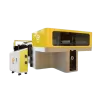Stamping 2D and 3d manipulators
Stamping is a forming method that uses a press and a mold to apply external force to plates, strips, pipes and profiles to cause plastic deformation or separation, thereby obtaining a workpiece (stamping part) of the required shape and size. The multi-station stamping method is to arrange the molds of multiple processes on a punch press, and use the reciprocating movement of the punch press slider to make multiple molds installed on the machine tool for blanking, punching, bending, stretching, trimming, etc. move simultaneously. In a round-trip cycle, the manipulator transfers the workpiece from the previous station to the next station, thereby obtaining a complete part. It can be divided into two-dimensional and three-dimensional manipulator handling methods.
Stamping 2D manipulator is an automated equipment used in stamping production, which mainly grabs and transfers workpieces in a two-dimensional plane. I. Working principle (1) Drive system: The servo motor drives the connecting rod mechanism to move the grabbing device to the top of the specified workpiece, and then descends and grabs the workpiece.
(2) Transferring the workpiece: The gripping device clamps the workpiece, and the servo motor drives the connecting rod mechanism to transfer the workpiece to the target position. (3) Releasing the workpiece: After reaching the target position, the gripping device releases the workpiece, and the manipulator returns to the initial position and waits for the next operation instruction. II. Advantages (1) High efficiency: It can quickly complete the gripping and delivery of the workpiece, significantly improving production efficiency.
(2) High precision: The precision control system and sensors are used to ensure the accurate positioning and transfer of the workpiece. (3) Stability: The structure is simple, maintenance is convenient, and it has high stability and reliability. (4) Flexibility: The motion trajectory and operation parameters can be flexibly adjusted according to different production needs. III. Application scenarios
Stamping two-dimensional manipulators are widely used in hardware stamping, electronic product manufacturing, automobile manufacturing, home appliance manufacturing and other fields. They are used for the rapid transfer and positioning of workpieces to improve production efficiency and quality.

3D stamping manipulators are developed on the basis of stamping equipment and according to the characteristics of stamping production. They are specially developed to realize stamping automated unmanned production. They are motion control robots based on a three-dimensional coordinate system that can realize automatic positioning and retraction of metal sheets.
I. Structural composition
(1) Robotic arm: It is composed of multiple parts such as telescopic device and rotating device. It can move freely in the three directions of X, Y and Z to achieve precise positioning and operation in three-dimensional space. (2) Control system: It is used to accurately control the movement of the robot arm to ensure that the robot arm can move according to the predetermined trajectory and speed. (3) Actuator: It is responsible for converting the control signal into mechanical movement and driving the robot arm to complete various operation tasks. II. Technical features (1) High efficiency and stability: The power source is several independent servo motors, and the motion controller has the function of synchronous operation with the punch press to ensure the stability and efficiency of the production process. (2) Easy operation: The control panel adopts PLC + touch screen, which has good stability, simple operation, easy to learn and use. When reprogramming the product during production replacement, it can be completed in the shortest time. (3) High safety: It has the function of misfeed detection circuit to ensure the safety of molds and equipment. At the same time, light curtain monitoring, interlocking punch press and peripheral equipment also further improve the safety of production. III. Application scenarios (1) Metal stamping: stamping production of products such as rice cookers, motor housings, hot water kettles, and soymilk machine trays. (2) Auto parts: stamping and assembly of auto parts. (3) Electronic products: stamping production of electronic products such as laptop shells and mobile phone shells. (4) Home appliances: stamping production of home appliances such as TV shells and air conditioner accessories.
Differences between stamping two-dimensional and three-dimensional manipulators
I. Degree of freedom of movement (1) Two-dimensional manipulators usually have only two degrees of freedom of movement, namely translational movement of the X-axis and Y-axis. This type of manipulator is suitable for grasping and transferring workpieces in a plane. (2) Three-dimensional manipulators have three degrees of freedom of movement, namely translational movement of the X-axis, Y-axis and Z-axis, and rotational movement around these three axes. This type of manipulator can perform complex movements in three-dimensional space.
II. Structure and cost (1) Due to the small number of degrees of freedom of movement, the structure of the two-dimensional manipulator is relatively simple and the cost is low. (2) With more degrees of freedom of movement, the structure of the three-dimensional manipulator is relatively complex and the cost is high.
III. Application scenarios (1) Two-dimensional manipulators are mainly used for simple stamping tasks, such as grasping and transferring small workpieces. (2) The three-dimensional manipulator is mainly used for complex stamping tasks, such as grasping and transferring large workpieces, and operations that require precise positioning in three-dimensional space.
In the field of stamping automation, two-dimensional manipulators and three-dimensional manipulators have become important members of the production line due to their unique advantages and functions. Two-dimensional and three-dimensional stamping manipulators are suitable for processing in the stamping industry such as hardware stamping, computers, electronics, electrical appliances, home appliances, electrical appliances, automobiles, standard parts industries, etc. It replaces manual feeding and automatically loads/unloads/carries/grasps/stamps, etc., improves production efficiency, ensures product quality, improves workers' labor intensity, and ensures personal safety.

